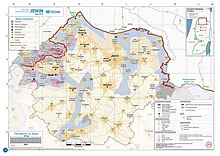Jenin
This page is subject to the extended confirmed restriction related to the Arab-Israeli conflict.Jenin (/ʒɪˈniːn/ zhin-EEN; Arabic: جنين, romanized: Jinīn, locally pronounced [ʒɪˈniːn] ⓘ) is a city in the State of Palestine in the Israeli-occupied West Bank.
[1][4] The camp has since become a stronghold of Palestinian militants against British colonialism and Israeli occupation, being the location of several incidents relating to the Israeli–Palestinian conflict.
With Roman procurator Cumanus failing to respond, Jewish Zealots led by Elazar the Son of Deinaeus (Ben Dinai) sought vengeance, and several Samaritan villages in Aqrabatene were destroyed.
[24] There is no mention of Jenin in the reports of the Muslim conquest of the Levant from the Byzantines, which, according to the historian Moshe Sharon, "is not surprising, since it was a small place of minor importance".
[25] Shortly before the Battle of Hattin in 1187, Jenin was captured by the Ayyubid sultan Saladin,[25] who destroyed the nearby fort, Castellum Beleismum.
[27] In the 1220s, the geographer Yaqut al-Hamawi described Jenin as "a small and beautiful town, lying between Nabulus and Beisan, in the Jordan Province.
[29] In the late 13th century, Mamluk emirs (commanders) stationed at Jenin were ordered by Sultan Qalawun (r. 1279–1290) "to ride every day with their troops before the fortress of 'Akka, so as to protect the coast and the merchants.
They paid a fixed tax rate of 25% on agricultural products, including wheat, barley, summer crops, goats and beehives, in addition to occasional revenues; a total of 2,000 akçe.
[36] The Turabays, who remained nomads in the plain between Mount Carmel and Caesarea, made Jenin the administrative headquarters of Lajjun and used the town's Izz al-Din Cemetery to bury their dead.
[40] There are indications that the area comprising Jenin and Nablus remained functionally autonomous under Ottoman rule and that the empire struggled to collect taxes there.
[44] In 1882, the PEF's Survey of Western Palestine described Jenin as "The capital of the district, the seat of a Caimacam, a town of about 3,000 inhabitants, with a small bazaar.
A spring rises east of the town and is conducted to a large masonry reservoir, near the west side, of good squared stonework, with a long stone trough.
This reservoir was built by 'And el Hady, Mudir of Acre, in the first half of the century [..], north of the town is the little mosque of 'Ezz ed Din, with a good- sized dome and a minaret.
"[45] According to a census conducted in 1922 by the British Mandate authorities, Jenin had a population of 2,637 (2,307 Muslims, 212 Hindus, 108 Christians, seven Jews, and three Sikhs).
Despite having captured and killed the assassin, British forces ordered the inhabitants to leave, and blew up one quarter of the town as a form of punishment.
[51] In the 1948 Arab–Israeli War, the city was defended by the Iraqi Army, then captured briefly by the forces from Israel's Carmeli Brigade during the "Ten Days' fighting" following the cancellation of the first cease-fire.
[56] Israeli army weekly Bamahane attributes at least 31 militant attacks, totaling 124 victims, to Jenin during the same period, more than any other city in the West Bank.
Medical staff were shot at (one nurse killed) while trying to reach the wounded even after clearly being in uniform displaying the red crescent symbol.
During a gun-battle with Islamic Jihad militants whom Israel says were firing at troops from inside the UN compound, an Israeli military sniper shot and killed a UN Relief and Works Agency (UNRWA) employee, Iain Hook (54) on November 22, 2002.
[69] On 6 February 2020, a Palestinian policeman, Tarek Badwan, was shot dead by an Israeli sniper as he stood at the entrance to the Jenin police station and chatted with a colleague.
[71] On 26 January 2023, Israeli forces killed nine in a clash with Islamic Jihad militants during a raid in the city and refugee camp of Jenin.
Israel claimed that while they were targeting suspected members of the Jenin Brigades, an armed group, they acknowledged that innocent people may have been injured or killed in the raid.
By June 2024 repeated bombing attacks and incursions with bulldozers by Israeli forces had razed every street and reduced every public square to rubble.
[79][80] In late August 2024 Israel launched a large-scale, multi-day raid on Jenin as part of Operation Summer Camps, with one resident saying that "The water is cut off.
The governor of Jenin said that "The Israelis are besieging the hospitals and cutting off the city from the refugee camp, which has become a military zone with no access...neither the civil defence, nor the ambulances, nor the journalists can go and see what is happening there."
[84] Additionally, the Israeli forces fired at ambulances carrying "a dead and a wounded person",[84] leading to the injury of 2 EMTs and a volunteer doctor.
News reports include videos of this attack, as well as assertions by the Israel Defense Forces that it is rooting out terrorism; and that it "undertakes all feasible precautions to avoid damaging essential infrastructure”, while acknowledging that these “operations in the area have caused unavoidable harm to certain civilian structures".
[89][90] Jenin is situated at the foot of the rugged northernmost hills (Jabal Nablus) of the West Bank, and along the southern edge of the Jezreel Valley (Marj Ibn Amer),[91] which the city overlooks.
[96] The nearest localities are Umm at-Tut and Jalqamus to the southeast, Qabatiya and Zababdeh to the south, Burqin to the southwest, Kafr Dan to the west, Arranah, Jalamah and the Arab Israeli village of Muqeible to the north, Deir Ghazaleh to the northeast, and Beit Qad and Deir Abu Da'if to the east.
The ancient cemetery in Jenin houses the tomb of Sheikh Izz al-Din, a Sufi saint of the Rifa'i order.












